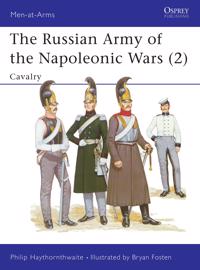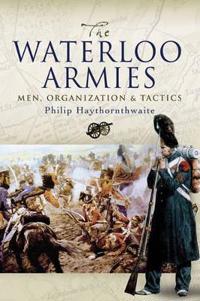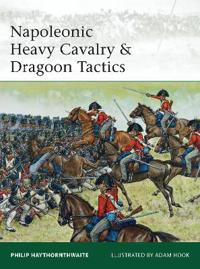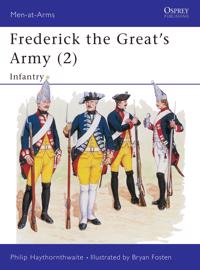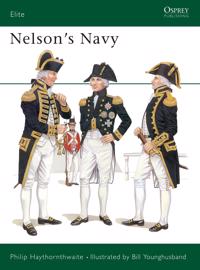The Internet in Everyday Life (Häftad)
avCaroline Haythornthwaite, Wellman, Haythornthwaite
ISBN: 9780631235088 - UTGIVEN: 200212The Internet in Everyday Life is the first book to systematically investigate how being online fits into peoplea s everyday lives. * Opens up a new line of inquiry into the social effects of the Internet. * Focuses on how the Internet fits into everyday lives, rather than considering it as an altern[...]
The Russian Army of the Napoleonic Wars (2) (Pocket)
avPhilip J. Haythornthwaite, Martin (EDT) Windrow, Philip J. Haythornthwaite
ISBN: 9780850457469 - UTGIVEN: 1987-07During the Napoleonic era, Russia possessed a vast force of cavalry, forming a greater percentage than that of most European armies. This stemmed partly from their service against the Turks, who had huge numbers of troops, and partly from the fact that much Russian terrain was suitable for the manoe[...]
British Napoleonic Infantry Tactics 1792-1815 (Pocket)
avPhilip J. Haythornthwaite, Steve Noon, Philip J. Haythornthwaite
ISBN: 9781846032226 - UTGIVEN: 200806The British Army that faced Napoleon in the Peninsula was small by continental standards, but it consistently out-fought larger French armies, never losing a major open-field action.[...]
Borodino 1812 (Pocket)
avPhilip J. Haythornthwaite, Peter Dennis, Philip J. Haythornthwaite
ISBN: 9781849086967 - UTGIVEN: 201209The battle of Borodino was one of the greatest encounters in European history, and one of the largest and most sanguinary in the Napoleonic Wars. Following the breakdown of relations between Russia and France, Napoleon assembled a vast Grande Armee drawn from the many states within the French sphere[...]
The Internet in Everyday Life (Övrig)
avEditor:barry Wellman, Editor:caroline Haythornthwaite
ISBN: 9780470774298 - UTGIVEN: 2008-02-29The Russian Army of the Napoleonic Wars (1) (Pocket)
avPhilip J. Haythornthwaite
ISBN: 9780850457377 - UTGIVEN: 1987-03In 1795 the Russian army was as vast as the territory from which it was drawn. The College of War calculated that the regular army amounted to 541,741 men, plus 46,601 enrolled cossacks, and at least a further 100,000 irregular cavalry which could be mobilised in time of war. Inspired by the icons p[...]
The Waterloo Armies (Inbunden)
avPhilip J. Haythornthwaite
ISBN: 9781844155996 - UTGIVEN: 200710Waterloo is one of the most famous battles in history and it has given rise to a vast and varied literature. The strategy and tactics of the battle and the entire Waterloo campaign have been analysed at length. The commanders, manoeuvres and critical episodes, and the intense experiences of the men [...]
Redcoats: The British Soldiers of the Napoleonic Wars (Inbunden)
avHaythornthwaite, Philip J
ISBN: 9781844159581 - UTGIVEN: 2012-05-17In this landmark book Philip Haythornthwaite traces the career of a British soldier from enlistment, through the key stages of his path through the military system, including combat, all the way to his eventual discharge. His fascinating account shows how varied the recruits of the day were, from ur[...]
Napoleonic Heavy Cavalry & Dragoon Tactics (Häftad)
avPhilip J. Haythornthwaite
ISBN: 9781849087100 - UTGIVEN: 201307During the Napoleonic Wars the supreme battlefield shock weapon was the heavy cavalry - the French cuirassiers, and their British, Austrian, Prussian and Russian counterparts. Big men mounted on big horses, the heavy cavalry were armed with swords nearly a metre long, used for slashing or thrusting [...]
E-learning Theory and Practice (Häftad)
avRichard N. L. Andrews, Caroline Haythornthwaite
ISBN: 9781849204712 - UTGIVEN: 201104In E-learning Theory and Practice the authors set out different perspectives on e-learning. The book deals with the social implications of e-learning, its transformative effects, and the social and technical interplay that supports and directs e-learning. The authors present new perspectives on the [...]
Frederick the Great's Army (Häftad)
avPhilip J. Haythornthwaite
ISBN: 9781855321601 - UTGIVEN: 1991-11Throughout the wars undertaken by Frederick the Great, probably his greatest resource was his infantry. It is a mark of the king's determination that despite wars which almost destroyed both Prussia and its army (such as the Seven Years' War), he was able to maintain its numbers - even if the qualit[...]
Nelson's Navy (Häftad)
avPhilip J. Haythornthwaite
ISBN: 9781855323346 - UTGIVEN: 199309Despite the many celebrated victories of the British Army during the Napoleonic Wars (1799-1815), the role of the Royal Navy should never be overlooked. The 'wooden walls' formed the country's first and most important line of defence, and ranged throughout the world to protect Britain's trade-routes[...]


